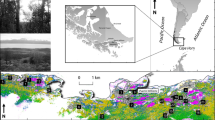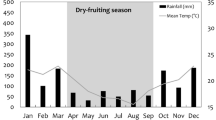Abstract
Resource depression caused by current feeding and the rate of resource renewal should influence foragers' decisions about when to revisit foraging areas. Adjustment of foraging paths and revisit rates should be particularly important when resources renew slowly. Foragers can also benefit by returning more often to highly profitable than to less profitable foraging areas. Many highly frugivorous primates seem to time revisits to fruit sources so as to harvest fruit efficiently and, also, use efficient search paths. Fewer data on non-frugivores exist. Mountain gorillas are folivores that eat mostly perennially available, continuously growing herbs and vines. Vegetation regenerates slowly from the effects of gorilla trampling, though trampling can also facilitate food species productivity, at least in the short term. Adjustment of intervals between visits to foraging areas to the extent of previous use and to resource renewal rates should increase gorilla foraging efficiency. Long-term data on habitat use by 6 mountain gorilla social units show that revisit intervals vary in association with variation in the extent of previous use and in plant productivity. However, they also revisit areas more often, the higher the biomass and nutritional quality of food there. These data are generally consistent with the hypothesis that the gorillas crop resources on a sustained-yield basis, though more precise data on areal revisits and complementary long-term data on vegetation composition would be needed to test the hypothesis.
Similar content being viewed by others
REFERENCES
Altmann, S. A. (1974). Baboons, space, time, and energy. Amer. Zool. 14: 221–248.
Bell, W. J. (1991). Searching Behavior, Chapman and Hall, New York.
Bennet, E. L. (1986). Environmental correlates of ranging behavior in the banded langur, Presbytis melelophos. Folia Primatol. 47: 26–38.
Charnov, E. L. (1976). Optimal foraging: The marginal value theorem. Theor. Popul. Biol. 9: 129–136.
Cody, M. (1971). Finch flocks in the Mohave Desert. Theor. Popul. Biol. 2: 142–158.
Clutton-Brock, T. H. (1975). Ranging behaviour of red colobus (Colobus badius tephrosceles) in the Gombe National Park. Anim. Behav. 23: 706–722.
Davies, N. B., and Houston, A. I. (1981). Owners and satellites. J. Anim. Ecol. 50: 157–180.
Fossey, D., and Harcourt, A. H. (1977). Feeding ecology of free-ranging mountain gorillas (Gorilla gorilla beringei). In Clutton-Brock, T. H. (ed.), Primate Ecology, Academic Press, London, pp. 415–477.
Fryxell, J. M. (1995). Aggregation and migration by grazing ungulates in relation to resources and predators. In Sinclair, A. R. E., and Arcese, P. (eds.), Serengeti II: Dynamics, Management, and Conservation of an Ecosystem, University of Chicago Press, Chicago, pp. 257–273.
Fryxell, J. M., Grearer, J., and Sinclair, A. R. E. (1988). Why are migratory ungulates so abundant? Am. Nat. 131: 781–798.
Garber, P. A. (1989). Role of spatial memory in primate foraging patterns: Saguinus mystax and Saguinus fuscicollis. 19: 203–216.
Gautier-Hion, A., Quris, R., and Gautier-Hion, J. P. (1983). Monospecific versus polyspecific life: A comparative study of foraging and anti-predatory tactics in a community of Cercopithecus monkeys. Behav. Ecol. Sociobiol. 12: 325–335.
MacKinnon, J. (1974). The behavior and ecology of wild organutans (Pongo pygmaeus). Anim. Behav. 22: 3–74.
MacNaughton, S. J., and Banyikwa, F. F. (1995). Plant communities and herbivory. In Sinclair, A. R. E. and Arcese, P. (eds.), Serengeti II: Dynamics, Management, and Conservation of an Ecosystem, University of Chicago Press, Chicago, pp. 49–70.
McNeilage, A. J. (1995). Mountain Gorillas in the Virunga Volcanos: Ecology and Carrying Capacity, Ph.D. thesis, University of Bristol, Bristol.
Marsh, C. (1981). Ranging behaviour and its relation to diet selection in the Tana River red colobus (Colobus badius rufomitratus). J. Zool. London 195: 473–492.
Milton, K. (1980). The Foraging Strategy of Howler Monkeys, Columbia University Press, New York.
Nunes, A. (1995). Foraging and ranging behavior in white-bellied spider monkeys. Folia Primatol. 65: 85–99.
Peres, C. (1992). Consequences of joint territoriality in a mixed-species group of tamarin monkeys. Behaviour 123: 220–246.
Plumptre, A. (1993). The effects of trampling damage by herbivores on the vegetation of the Park National des Volcans, Rwanda. Afr. J. Ecol. 32: 115–129.
Plumptre, A. (1995). The chemical composition of montane plants and its influence on the diet of the large mammalian herbivores in the Parc National des Volcans, Rwanda. J. Zool. London 235: 323–337.
Pyke, G. H., Pulliam, H. R., and Charnov, E. L. (1977). Optimal foraging theory: A selective review of theory and tests. Q. Rev. Biol. 52: 137–154.
Robinson, J. (1986). Seasonal variation in use of time and space by the wedge-capped capuchin monkey, Cebus olivaceous: Implications for foraging theory. Smithson. Contrib. Zool. 431: 1–60.
Sinclair, A. R. E., (1995). Equilibria in plant herbivore interactions. In Sinclair, A.R.E. and Arcese, P. (eds.), Serengeti II: Dynamics, Management, and Conservation of an Ecosystem, University of Chicago Press, Chicago, pp. 91–114.
Sterck, E. L. (1997). Determinants of female dispersal in Thomas langurs. Am. J. Primatol. 42: 179–198.
Sutherland, W. (1995). From Individual Behaviour to Population Ecology, Oxford University Press, Oxford.
Terborgh, J. (1983). Five New World Primates, Princeton University Press, Princeton, NJ.
Vedder, A. L. (1984). Movement patterns of a group of free-ranging mountain gorillas (Gorilla gorilla beringei) and their relationship to food availability. Am. J. Primatol. 7: 73–88.
Waser, P. (1984). Ecological differences and behavioral contrasts between two mangabey species. In Rodman, P. S., and Cant, J. G. H. (eds.), Adaptations for Foraging in Nonhuman Primates, Columbia University Press, New York, pp. 195–216.
Watanuki, Y., Nakayama, Y., Azuma, S., and Ashizawa, S. (1994). Foraging on buds and bark of mulberry trees by Japanese monkeys and their range utilization. Primates 35: 15–24.
Waterman, P. G., and Kool, K. (1994). Colobine food selection and food chemistry. In Davies, G. L., and Oates, J. F. (eds.), Colobine Monkeys: Their Behavior, Ecology, and Evolution, Cambridge University Press, Cambridge, pp. 251–284.
Watts, D. P. (1984). Composition and variability of mountain gorilla diets in the central Virungas. Am. J. Primatol. 7: 323–356.
Watts, D. P. (1987). Effects of mountain gorilla foraging activities on the productivity of their food species. Afr. J. Ecol. 25: 155–163.
Watts, D. P. (1988). Environmental influences on mountain gorilla time budgets. Am. J. Primatol. 15: 295–312.
Watts, D. P. (1991). Strategies of habitat use by mountain gorillas. Folia Primatol. 56: 1–16.
Watts, D. P. (1994). The influence of male mating tactics on habitat use in mountain gorillas. Primates 35: 35–47.
Watts, D. P. (1998a). Long-term habitat use by mountain gorillas (Gorilla gorilla beringei). 1. Consistency, variation, and home range size and stability. Int. J. Primatol. 19: 651–680.
Watts, D. P. (1998b). Seasonality in the ecology and life histories of mountain gorillas (Gorilla gorilla beringei) (submitted for publication).
Wilmhurst, J. F., Fryxell, J. M., and Hudson, R. J. (1995). Forage quality and patch choice by wapiti (Cervus elephus). Behav. Ecol. 6: 209–217.
Yamagiwa, J. (1986). Activity rhythm and the ranging of a solitary male gorilla mountain gorilla (Gorilla gorilla beringei). Primates 27: 273–282.
Zach, R., and Falls, J. B. (1976a). Ovenbirds (Aves:Parulidae) hunting behavior in a patchy environment: An experimental study. Can. J. Zool. 54: 1863–1879.
Zach, R., and Falls, J. B. (1976b). Foraging behavior, learning and exploration by captive ovenbirds. Can. J. Zool. 54: 1880–1893.
Author information
Authors and Affiliations
Rights and permissions
About this article
Cite this article
Watts, D.P. Long-Term Habitat Use by Mountain Gorillas (Gorilla gorilla beringei). 2. Reuse of Foraging Areas in Relation to Resource Abundance, Quality, and Depletion. International Journal of Primatology 19, 681–702 (1998). https://doi.org/10.1023/A:1020376925939
Issue Date:
DOI: https://doi.org/10.1023/A:1020376925939




